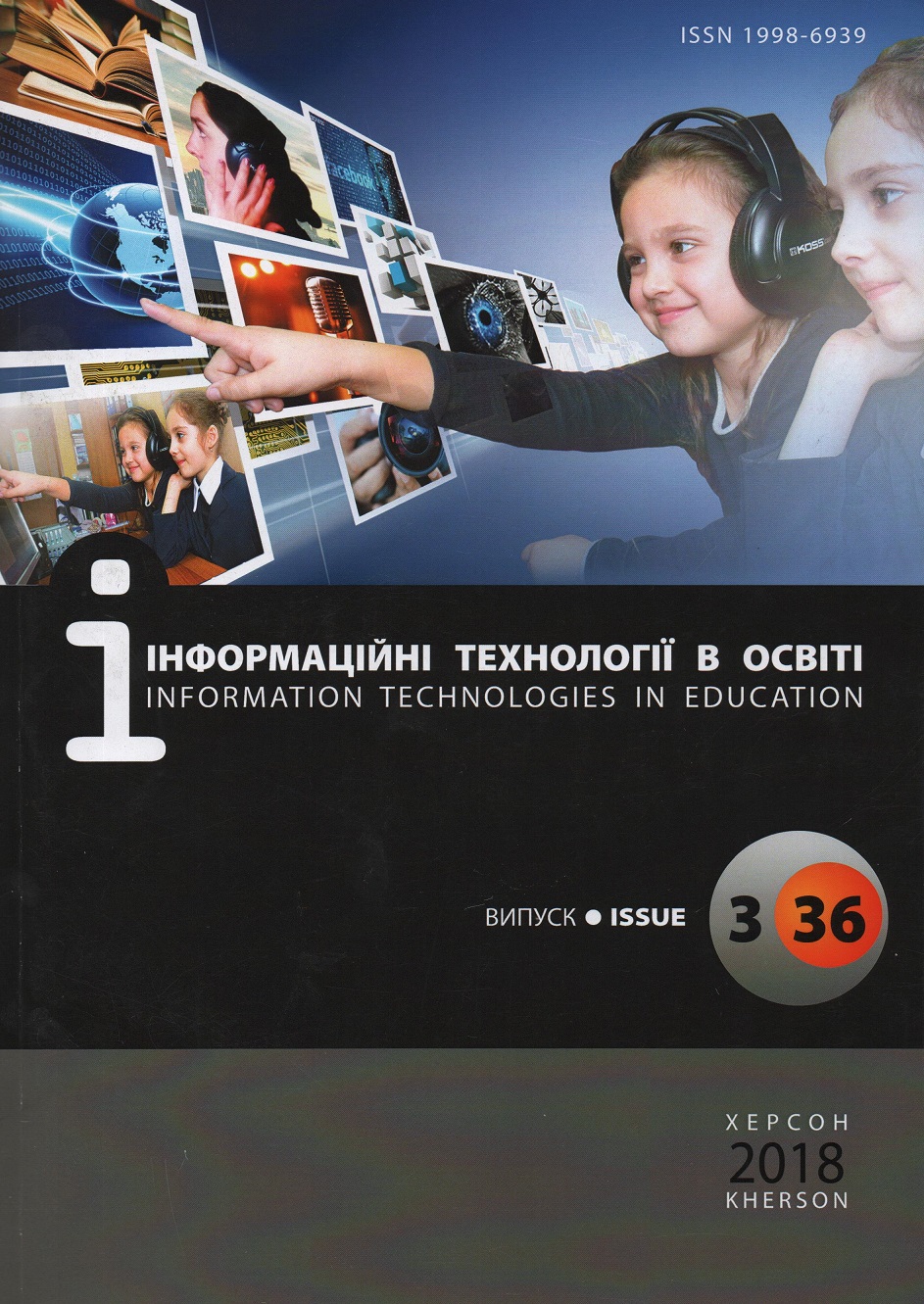СOCALC ЯК ІНСТРУМЕНТ ПІДГОТОВКИ ДЛЯ МОДЕЛЮВАННЯ НЕЙРОННИХ МЕРЕЖ У СПЕЦІАЛЬНОМУ КУРСІ "ОСНОВИ МАТЕМАТИЧНОЇ ІНФОРМАТИКИ"
DOI:
https://doi.org/10.14308/ite000674Ключові слова:
CoCalc, хмарні технології, моделювання нейронних мереж, основи математичної інформатикиАнотація
У статті розглянута роль моделювання нейронної мережі в навчальному процесі спеціального курсу "Основи математичної інформатики". Курс був розроблений для студентів технічних університетів - майбутніх спеціалістів з інформаційних технологій та спрямований на подолання розриву між теоретичною інформатикою та її прикладними програмами: програмною, системною та комп’ютерною інженерією. CoCalc розглядається як навчальний інструмент математичної інформатики в цілому та, зокрема, для моделювання нейронних мереж. Показані елементи методики використання CoCalc при вивченні теми "Нейронні мережі та розпізнавання образів" спеціального курсу "Основи математичної інформатики". Код програми був представлений на мові CofeeScript, в якій реалізуються основні компоненти штучної нейронної мережі: нейрони, синаптичні з'єднання, функції активації (тангенціальні, сигмоїдні, ступінчасті) та їх похідні, методи розрахунку ваги мережі та ін. Обговорювалися особливості застосування теореми Колмогорова для визначення архітектури багатошарових нейронних мереж. В якості прикладів було наведено реалізацію диз'юнктивного логічного елемента та наближення довільної функції за допомогою тришарової нейронної мережі. Згідно результатів моделювання, було зроблено висновок щодо меж використання побудованих мереж, в яких вони зберігають свою адекватність. Запропоновано основні теми окремих досліджень штучних нейронних мереж.
Завантаження
Показники метрики:
Посилання
1. Markova, O.M., Semerikov, S.O. & Striuk, A. M. (2015). The cloud technologies of learning: origin. Information Technologies and Learning Tools, 46(2), 29-44.
2. Permiakova, O.S. & Semerikov, S.O. (2008). The use of neural networks in forecasting problems. Materials of the International Scientific and Practical Conference “Young scientist of the XXI century”, KTU, Kryviy Rih, 17-18 November 2008.
3. Popel, M.V. (2015). Organization of learning mathematical disciplines in SageMathCloud. Publishing Department of the Kryviy Rih National University, Kryviy Rih.
4. SageMath, Inc. (2018). CoCalc - Collaborative Calculation in the Cloud. Retrieved from https://cocalc.com.
5. Semerikov, S., Teplytskyi, I. & Yechkalo, Yu. (2018). Computer Simulation of Neural Networks Using Spreadsheets: The Dawn of the Age of Camelot.Proceedings of the 14th Interna-tional Conference on ICT in Education, Research and Industrial Applications. Integration, Harmonization and Knowledge Transfer. Kyiv, 14-17 May 2018. CEUR Workshop Pro-ceedings.
6. Shokaliuk, S.V., Markova, O.M., Semerikov, S.O. & Soloviov, V.M. (Ed.) (2017). SageMathCloud as the Learning Tool Cloud Technologies of the Computer-Based Studying Mathematics and Informatics Disciplines. Modeling in Education: State. Problems. Prospects, 130-142.
7. Stein, W. (2014). What can SageMathCloud (SMC) do? Sage: open source mathematics software. Retrieved from http://sagemath.blogspot.com/2014/05/what-can-sagemathcloud-smc-do.html.
8. Teplytskyi, I.O. & Semerikov, S.O. (2007). Computer simulation of absolute and relative motions of the planets the Solar system. Collection of scientific works of the Kamyanets-Podilsky National University named after Ivan Ogienko. Series: Pedagogical, 13, 211-214.
9. Turavinina, O.M. & Semerikov, S.O. (2012). Contents of the learning of the foundations of mathematical informatics of students of technical universities. Proceedings of the International scientific and methodical conference on Development of intellectual abilities and creative abilities of students and students in the process of teaching disciplines of the natural sciences and mathematics cycle, Sumy State Pedagogical University named after A. S. Makarenko, Sumy, 6-7 December 2012.
10. Turavinina, O.M. (2012). Mathematical informatics in the system fundamen-talization learning the students of technical universities. Collection of scientific works of the Kamyanets-Podilsky National University named after Ivan Ogienko. Series: Pedagogical, 18, 189-191.
</uk>
<en>
1. Markova, O.M., Semerikov, S.O. & Striuk, A. M. (2015). The cloud technologies of learning: origin. Information Technologies and Learning Tools, 46(2), 29-44.
2. Permiakova, O.S. & Semerikov, S.O. (2008). The use of neural networks in forecasting problems. Materials of the International Scientific and Practical Conference “Young scientist of the XXI century”, KTU, Kryviy Rih, 17-18 November 2008.
3. Popel, M.V. (2015). Organization of learning mathematical disciplines in SageMathCloud. Publishing Department of the Kryviy Rih National University, Kryviy Rih.
4. SageMath, Inc. (2018). CoCalc - Collaborative Calculation in the Cloud. Retrieved from https://cocalc.com.
5. Semerikov, S., Teplytskyi, I. & Yechkalo, Yu. (2018). Computer Simulation of Neural Networks Using Spreadsheets: The Dawn of the Age of Camelot.Proceedings of the 14th Interna-tional Conference on ICT in Education, Research and Industrial Applications. Integration, Harmonization and Knowledge Transfer. Kyiv, 14-17 May 2018. CEUR Workshop Pro-ceedings.
6. Shokaliuk, S.V., Markova, O.M., Semerikov, S.O. & Soloviov, V.M. (Ed.) (2017). SageMathCloud as the Learning Tool Cloud Technologies of the Computer-Based Studying Mathematics and Informatics Disciplines. Modeling in Education: State. Problems. Prospects, 130-142.
7. Stein, W. (2014). What can SageMathCloud (SMC) do? Sage: open source mathematics software. Retrieved from http://sagemath.blogspot.com/2014/05/what-can-sagemathcloud-smc-do.html.
8. Teplytskyi, I.O. & Semerikov, S.O. (2007). Computer simulation of absolute and relative motions of the planets the Solar system. Collection of scientific works of the Kamyanets-Podilsky National University named after Ivan Ogienko. Series: Pedagogical, 13, 211-214.
9. Turavinina, O.M. & Semerikov, S.O. (2012). Contents of the learning of the foundations of mathematical informatics of students of technical universities. Proceedings of the International scientific and methodical conference on Development of intellectual abilities and creative abilities of students and students in the process of teaching disciplines of the natural sciences and mathematics cycle, Sumy State Pedagogical University named after A. S. Makarenko, Sumy, 6-7 December 2012.
10. Turavinina, O.M. (2012). Mathematical informatics in the system fundamen-talization learning the students of technical universities. Collection of scientific works of the Kamyanets-Podilsky National University named after Ivan Ogienko. Series: Pedagogical, 18, 189-191.
</en>
##submission.downloads##
Опубліковано
Як цитувати
Номер
Розділ
Ліцензія
This work is licensed under a Creative Commons Attribution-NonCommercial-ShareAlike 4.0 International License.






























